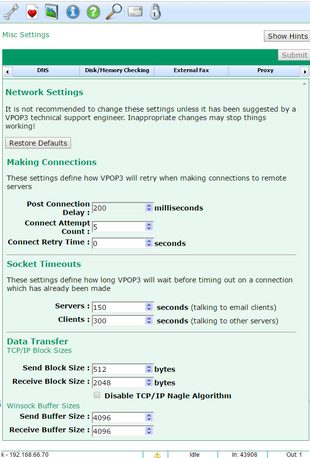
To get to this page, go to Settings → Misc Settings → Network.
You will normally not need to change any settings on this page unless VPOP3 technical support have suggested it.
If you do make changes, and want to go back to the original settings, the Restore Defaults button will restore the settings to their defaults.
Post Connection Delay is how long VPOP3 will wait after connecting to the remote POP3/SMTP mail server before it starts sending or collecting mail.
Connect Attempt Count is how many times VPOP3 will try to connect to the remote POP3/SMTP mail server before it gives up and reports an error.
Connect Retry Time is the amountof time between attempts to connect to the remote POP3/SMTP mail server.
The Socket Timeouts are idle timeouts for connections. The Servers timeout is for the server processes in VPOP3 when they are talking to email clients. The Clients timeout is for the client processes in VPOP3 when they are talking to other mail servers. Note that some timeouts can be overridden by other settings or standards. For instance, the IMAP4 standard requires a minimum of 30 minute timeout, so VPOP3 will have a 30 minute idle timeout for IMAP4 sessions, regardless of what the Servers timeout is set to here. Mail Senders can have different timeouts based on the phase of the connection, set in the Mail Sender Advanced tab.
The Data Transfer settings should never be altered unless indicated by VPOP3 technical support. The defaults make sense and changing them too much can break things. Very occasionally problems with network drivers can mean these settings need to be changed, but, at the time of writing, we haven't encountered any such problems for over a decade.
The TCP/IP Block Sizes settings are buffer sizes used internally by VPOP3 to read or write data in blocks rather than as individual bytes.
The Disable TCP/IP Nagle Algorithm disables the Nagle algorithm in Windows which batches up individual TCP/IP send commands into one action.
The Winsock Buffer Sizes is the internal buffer size used by the Windows TCP Socket implementation.

